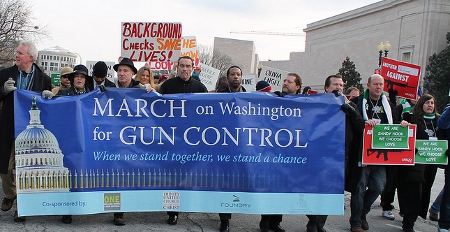 Despite support from around 90 percent of US citizens in the wake of 2012’s Sandy Hook School shooting, expanded background checks for gun purchases failed in the US Senate. Laurent Bouton, Paola Conconi, Francisco J Pino, and Maurizio Zanardi write that this ‘gun-control paradox’ can be explained by the fact that the intensity of voters’ preferences differs across policy issues, and voters only have one vote with which to hold politicians accountable on a bundle of issues. A model incorporating these features predicts Senate voting behaviour very well, finding that Senators closer to re-election are more likely to vote pro-gun, and only Democrats ‘flip-flop’ on guns.
Despite support from around 90 percent of US citizens in the wake of 2012’s Sandy Hook School shooting, expanded background checks for gun purchases failed in the US Senate. Laurent Bouton, Paola Conconi, Francisco J Pino, and Maurizio Zanardi write that this ‘gun-control paradox’ can be explained by the fact that the intensity of voters’ preferences differs across policy issues, and voters only have one vote with which to hold politicians accountable on a bundle of issues. A model incorporating these features predicts Senate voting behaviour very well, finding that Senators closer to re-election are more likely to vote pro-gun, and only Democrats ‘flip-flop’ on guns.
On 14 December 2012, 20 children and six staff members were murdered in a shooting at Sandy Hook Elementary School in Newtown, Connecticut. Building on the surge in public support for gun control that followed this tragedy, President Obama announced the formation of a task force to provide immediate recommendations on how to introduce new gun regulations to end the “epidemic of gun violence shaking the nation.”
A year has passed and Congress has been unable to introduce stricter gun regulations, despite broad public support. As pointed out by The Economist:
“when the push for more gun control began shortly after the Newtown shootings last December, the focus fell on three areas: assault weapons, high-capacity magazines and background checks. But the enthusiasm for new gun laws quickly faded, and it became obvious that efforts to ban assault weapons and high-capacity magazines would not win enough votes to pass. So gun-control advocates were left to pursue an expansion of the background-check system. In the end, even that was too ambitious.”

On 17 April 2013 even the mild effort to require background checks on private sales at gun shows and online failed in the Senate. This may seem surprising, given that all polls carried out at the time showed that a vast majority of US citizens supported this measure. As President Obama put it: “How can something have 90% support and yet not happen?”.
Explaining the gun-control paradox
The reluctance of US congressmen to support gun-control regulations, despite the fact that most US citizens are in favour of them, has long been a puzzle. Schuman and Presser (1978) referred to this puzzle as the “gun-control paradox”. As argued by Goss (2006), one possible explanation is that “American gun owners are intense, well organized, and willing to vote for or against candidates purely on the basis of their position on gun control”. They are a “highly motivated, intense minority”, who prevail over a “relatively apathetic majority”.
In a recent paper, we formalise this idea and provide empirical evidence that electoral incentives lead politicians to take a pro-gun stance, in line with the interests of a minority of the electorate. We propose a theoretical model in which politicians vote on a primary and a secondary policy issue. The former is an issue that a majority of voters cares relatively more about, such as the level of public spending. The latter is meant to capture gun control – an issue that a minority cares more intensely about. The minority may also be better-informed about the incumbent’s choices on the secondary policy issue. In this setting, citizens have only one vote to make their representatives accountable on a bundle of policy issues. Politicians may thus pander to the minority on the secondary issue, without losing too much support from the majority. The model delivers three testable predictions:
- First, politicians should be more likely to take a pro-gun stance at the end of their terms, when their policy choices have a bigger impact on their re-election prospects.
- Second, only politicians who are in favour of gun regulations and are concerned with re-election should ‘flip-flop’ on gun control, since they face a tension between their policy preferences and their re-election motives.
- Finally, election proximity should have no impact on the voting behaviour of politicians who are against gun regulations and/or are not concerned about re-election.
Voting behaviour in the US Senate
To assess the validity of these predictions, we examine the determinants of Senate votes on gun regulations over the period 1993–2010. The staggered structure of the US Senate – in which members serve six-year terms and a third is up for re-election every two years – provides a quasi-experimental setting to verify whether election proximity affects the voting behaviour of politicians on gun-related legislation. For any given vote, we can compare the behaviour of senators belonging to three different ‘generations’, i.e. who will be up for re-election at different times.
In line with the model predictions, we obtain three main results:
- First, the oldest generation of senators (i.e. those facing re-election within two years) is more likely to vote pro-gun than the previous two.
The effect is sizeable, and robust to using different econometric methodologies and samples of votes, and to including a wealth of controls for other drivers of senators’ voting behaviour on gun control. The pro-gun effect of election proximity continues to hold when, rather than exploiting variation in the voting behaviour of different senators, we study the behaviour of individual senators over time.
- Second, only Democratic senators flip-flop on gun control – in the last two years of their term, the probability that they vote pro-gun increases by between 15.3 percent and 18.9 percent.
- Finally, election proximity has no impact on the voting behaviour of senators who are not concerned with re-election, either because they are retiring or because they hold very safe seats.
Our results of the determinants of gun-control votes can help understand why Congress has not introduced stricter gun regulations in the wake of the tragedy in Newtown, despite overwhelming public support. Our empirical model does indeed predict the failure of the Senate to pass the Manchin–Toomey amendment on background checks last April. Based on our estimates for the period 1993–2010, we would have correctly predicted 93 out of 99 senators’ votes on the Manchin–Toomey amendment on 17 April 2013, excluding the Majority Leader Harry Reid, who voted against the amendment for procedural reasons. The Senate came short of the 60 votes needed to overcome a filibuster and move ahead with the legislation. Our predicted margin (51–48) is very close to the actual one (53–46), again excluding Harry Reid.
In representative democracies, policy choices often diverge from what the majority of the electorate wants. Our analysis suggests a twofold explanation:
1. Voters differ in the intensity of their preferences over different policy issues; and
2. They only have one vote to make their representatives accountable on a bundle of issues.
Obviously, financial pressure by lobby groups can also contribute to the lack of congruence between politicians’ choices and the preferences of the majority. Indeed, our empirical results confirm that senators who receive larger amounts of campaign contributions from gun-rights lobbies are more likely to take a pro-gun stance. Still, financial pressure by lobby groups cannot account for the pro-gun effect of election proximity on senators’ voting behaviour – even after controlling for the contributions received by individual senators throughout their terms, we find that they are more likely to vote pro-gun when they are closer to facing re-election. The power of gun-rights lobbies like the NRA may thus not only lie in their deep pockets, but also in the fact that their members are single-issue voters.
In principle, citizens’ initiatives could help to achieve better congruence between citizens’ preferences and policy outcomes, by unbundling different policy issues. In particular; stricter gun controls could be introduced in US states that allow ordinary citizens to place new legislation on a ballot for approval or rejection. For example, the Washington Universal Background Checks for Gun Purchases Initiative, also known as Initiative 594, may appear on the 4 November 2014 ballot in the state of Washington. If approved by voters, the measure would require background checks to be run on every person purchasing a gun in the state of Washington – even those who are doing so via private sales. However, even in the case of citizens’ initiatives, the intensity of voters’ preferences matters. For instance, organising initiatives is very costly both in terms of time and money, and citizens who strongly oppose gun regulations may be more willing to incur such costs. In addition, pro-gun citizens may be more willing to incur the costs of voting (e.g. spending time to register, rearranging work schedules, getting to the polls, and gathering information on the candidates). Thus an intense minority can still prevail over an apathetic majority.
This article originally appeared at VoxEU.
Please read our comments policy before commenting.
Note: This article gives the views of the authors, and not the position of USApp– American Politics and Policy, nor of the London School of Economics.
Shortened URL for this post: http://bit.ly/1f9Fljc
_________________________________
 Laurent Bouton – Georgetown University
Laurent Bouton – Georgetown University
Laurent Bouton is an Assistant Professor of Economics at Georgetown University, Associate Fellow at the European Center for Advanced Research in Economics and Statistics (ECARES), and Faculty Associate at the Institute for Economic Development (IED), Boston University. His main fields of interest are political economy, microeconomics, and public economics.
 Paola Conconi – European Center for Advanced Research in Economics and Statistics (ECARES)
Paola Conconi – European Center for Advanced Research in Economics and Statistics (ECARES)
Paola’s main research interests are in the areas of international trade and political economy. Paola holds a B.A. in Political Science from the University of Bologna, an M.A. in International Relations from the School of Advanced International Studies of Johns Hopkins University, and a M.Sc. and a Ph.D. in Economics from the University of Warwick. She is FNRS Research Associate at the European Center for Advanced Research in Economics and Statistics (ECARES) of the Université Libre de Bruxelles (ULB) and Research Fellow of the Centre for Economic Policy Research (CEPR).
 Francisco J Pino – Université Libre de Bruxelles
Francisco J Pino – Université Libre de Bruxelles
Francisco Pino is a post-doctoral researcher at the European Center for Advanced Research in Economics and Statistics (ECARES) of the Université Libre de Bruxelles (ULB). He holds a B.S. in Electrical and Industrial Engineering from the University of Chile, an M.A. in Political Economy from Boston University and a PhD in Economics from Boston University. His main fields of interest are political economy, development economics and economic history.
 Maurizio Zanardi – Lancaster University
Maurizio Zanardi – Lancaster University
Maurizio Zanardi is a Reader in Economics at Lancaster University Management School. Before joining the Department of Economics at the Lancaster University Management School, he held positions at the University of Glasgow (UK) and Tilburg University (Netherlands) and at the Université Libre de Bruxelles (Belgium). He is also a member of the Managing Board of the European Trade Study Group (ETSG). His main research interests are in the areas of international trade and political economy.




The flaw here is the basic premise of the authors’ assumption – that legislation should be temporally responsive to majority views in public opinion polls. This is neither the intent nor design of the relationship between the US government and the US people, as codified in the US Constitution. It did, admittedly, take centuries to overcome the popular consensus favoring enslavement of fellow human beings, suppression of political power of women and withheld minority rights in general, but this Constitution did eventually relieve many from the tyranny of majority rule. While these moral shortcomings were imported to the North American continent by our European ancestors, and slavery was further exploited in the Colonies for gains across the pond, America bears the responsibility for these transgressions once the US Constitution was ratified.
But let’s look at the argument the authors make despite this misreading of the US legal-political system. The authors stress the disconnect between polls taken “at the time” of the Sandy Hook tragedy (Jan-April 2013 polls) and the disconnect between a 92% agreement on the poll question “Do you favor or oppose background checks on all potential gun buyers” and failed passage of the specific text of the Manchin-Toomey Bill on background checks.
Firstly, the survey question itself presumed that mandatory/universal background checks were an effective means of keeping guns out of the hands of criminals. Immediately following the tragedy, the media flooded channels with the statistic that 40% of guns are obtained without background checks, looking to equate “keeping guns out of the hands of criminals” with “mandatory/universal background checks”. This data-bite was not qualified with the understanding that: “…the number comes from a 251-person survey on gun sales two decades ago, early in the Clinton administration. More than three-quarters of the survey covered sales before the Brady Act instituted mandatory federal background checks on February 28, 1994.” http://www.nationalreview.com/articles/338735/40-percent-myth-john-lott
Despite John Lott’s efforts to communicate to the public (over media commentators such as the screaming Piers Morgan – another UK export), the press did not pick up and disseminate his calculations that: “If you include these transfers either through FFLs or from family members, the remaining transfers falls to 11.5 percent. We don’t know the precise number today, but it is hard to believe that it is above single digits.”
Lott and others had testified before US government committees previously on guns and crime, so it is quite reasonable to consider that Senators knew that the public opinion polls were the result of misleading media collusion with gun control proponents. After all, those supporting these “sensible laws for responsible gun owners” remain those who made every attempt to outright ban gun possession by other than the military and law enforcement. Same foxes looking to guard the same chicken coop… http://www.huffingtonpost.com/2012/12/20/obama-gun-control-timeline_n_2338860.html
Secondly, public opinion ebbs and flows rapidly after every mass killing tragedy. By mid-summer, concerned was waning severely. Polls showed that those favoring gun rights remained more “intense”, as the authors put it, maintaining more concern and activity than did those favoring gun control. Critically, while there may be closer levels of “pseudo-activity” between the sides when considering scores based on Facebook “Likes” and clicking on online petitions, those favoring gun rights support their cause with money more often by a factor of 4- to-5-fold more frequently. http://www.pewresearch.org/key-data-points/gun-control-key-data-points-from-pew-research/
Recently, the Mothers Demand Action (MDA) claims 120,000+ “online members”, which corresponds to their Facebook “like” count. They appear financially broke, despite their touted membership roster, but we will never know from their 501c3 disclosure as they have merged with Mayors against Illegal Guns (MAIG). Billionaire Mayor Bloomberg will now be openly footing the bill as these virtual moms continue to click in support for his media expenditures on anti-gun ads. The media widely covered MDA’s intention to commemorate the 1 year anniversary of the Sandy Hook tragedy with bell-ringing vigils, but gave little coverage to the very small turn-out at the events. http://nhpr.org/post/new-hampshire-mothers-join-national-effort-tighter-gun-control-laws
Today, the majority do not favor stricter gun control. http://johnrlott.blogspot.com/2013/12/americans-opposing-more-gun-control-new.html Would the authors have us repeal the Manchin-Toomey laws? Once enacted, laws are very hard to reverse.
If we keep in the vein of the authors” preference to examine polls and politicians “at the time” of the tragedy (oddly defined as January-April, but not June, it appears), we might also examine other legislative actions in the same timeframe. Several state legislatures invoked emergency rules allowing legislators to pass more restrictive gun control laws with little time for debate or public input. Let’s look at some history. Gun owners and Congress are aware that California had systematically proposed and adopted gun licensing and registration laws, with the promise that gun owners could keep their guns. Later, once the laws were in place, they reversed and required surrender of some guns at risk of confiscation and felony conviction. http://www.wnd.com/1999/07/3745/ Even President Obama considers his promise that “I will not take your guns away” to exempt so-called “assault weapons” (now called “military-grade weapons”), magazines with >10 round capacity, etc. When is a promise not a promise when parsed and qualified?
Fast-forward to 2013. New York passed their SAFE Act in an emergency night session and the governor signed it the next morning, in a rush to be “First in the Nation” to take action following Sandy Hook. Now NY citizens are being arrested for crimes that don’t exist yet. http://www.syracuse.com/news/index.ssf/2013/11/most_ny_safe_act_arrests_so_far_for_crimes_that_pre-date_new_gun_laws.html
Soon after mandatory/universal background checks, assault weapons bans and high-capacity magazine bans were proposed by President Obama, a US Department of Justice memo, drafted at Obama’s request, surfaced indicating that such gun control actions would have little effect without registration and confiscation. The Administration quickly disclaimed the memo as a preliminary draft. http://thehill.com/blogs/blog-briefing-room/news/284527-nra-obtains-internal-justice-memo-contesting-obamas-gun-control-measures
So when debate on the Manchin-Toomey Bill was underway, there was good reason to suspect that the usual foxes had ulterior motives in their chicken coop security proposals.
The issue is far more complex than re-election eligibility, time to next election and campaign funding, although these are, no doubt, factors in the equation, whether cause or effect. UK/European academic struggle to understand guns in the US, assuming there is an error that simply needs to be exposed for correction.
We do indeed appear to be a violent society, with 1 in 14 imprisoned, and 1 in 23 for violent crimes. Some 250,000-370-000 Defensive Gun Uses (DGUs) per year (most without a shot fired) are estimated compared to 11,000 firearms homicides per year. Will making it harder for some criminals to get some guns sometimes, just make it harder for people to obtain guns to protect themselves from criminals?
Our firearms homicide rate is 1/80th of the fatality rate, but the 79/8oths get far less attention than that gun deaths. While 3-5% of mentally ill persons are considered violently mentally ill, proposed laws and funding (including Obama’s 23 Executive Orders) are focused on further burdening honest, law-abiding gun owners – Florida, for example, records a 0.00008% revocation rate for concealed carry license owners. The 3-5% are virtually ignored to focus on the 0.00008%? Hard to fathom.
But the key remains, the majority doesn’t rule in the US – we are a people governed by laws, not by mob rule.
The EU, et al, sure do put a lot of effort into devising schemes to disarm a foreign populace.
What the totalitarians – along with a number of Americans – fail to grasp is one simple fact: the US Constitution is clear on the powers NOT even on the table for debate; our God-given unalienable rights.
The Bill of Rights is a contract between the people and government wherein we the people temporarily transfer the functions and duties on our behalf, with the understanding that those powers are to be returned unmolested. The federal government is constrained by the [non-living] Constitution with the understanding they have legitimacy to operate within set boundaries right up until the point of pretending our rights are theirs to negotiate away.
Bottom line: it can come down to 1 lone citizen in whatever survey they choose for reference; the result is still the same. It is not, not ever been, a power of government to dissolve Providence delivered to Americans. Once it is understood and accepted – reluctantly begrudgingly – there is no debate to be had, we might finally dispense with the regularly scheduled “for your own good” gun-grab and devolve power back to the states as intended – relieving do-gooders from their tireless efforts to use government o legislate into law that which in any other hands would be criminal.